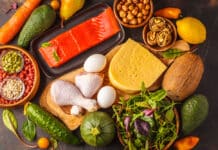So, do you want to know what the top 10 most frequently asked questions regarding the keto diet are? Well, lets jump into that right now.
1. Will I be hungry on the Ketogenic Diet?
2. How does the Ketogenic Diet work?
3. How is weight loss achieved on the Ketogenic Diet?
4. Why is it conventional diet methods just don’t work?
5. What is the difference between a Low Carbohydrate Diet and the Ketogenic Diet?
6. Do I need to count calories?
7. How do I track my macros/ carb intake?
8. How long does it take to get into Ketosis?
9. What is Keto adaptation?
10. How much weight will I lose and how fast?

TOP 10 MOST FREQUENTLY ASKED KETO DIET QUESTIONS
1. Will I be hungry on the Ketogenic Diet?
One of the most common and surprising effects of adapting to the keto diet is always feeling full. You will probably feel the difference within a week or so of starting keto. If you commonly feel hungry between meals or hunger pangs within a few hours of eating you will notice these feelings begin to fade quickly.
This is one of many reasons people who start a ketogenic diet and breeze through the first week, have no problem staying on it long term. It easily changes the way you view food in general.
Many diets you may have tried in the past have probably left you with a feeling of frustration and most always leave you with a feeling of hunger. Not the ketogenic diet. The increased amount of fat you eat each day keeps you feeling satisfied and full, and with the lack of insulin spikes don’t make you crave food when your body doesn’t need it. Fats and protein are what our bodies are designed to run on. Not sugars/carbs and chemically processed foods.
2. How does the Ketogenic diet work?
Foods with generous amounts of fat and protein help keep your blood sugar in check while producing a feeling of satisfaction. Egg yolks contain lutein which are great for your eyes. It has been embedded in our brains (probably since birth) that eggs and red meats are bad for you. Well I’m here to tell you to forget what you think about healthy diets!! Throw out those low-fat, no sugar added, 100 calorie packs, because those are what has been making this country fatter for years.
Along with fat and protein, there are many other foods that give you that satisfied feeling. Vegetables like broccoli and cauliflower have appetite suppressing effects. These vegetables are very bulky and full of fiber making your stomach feel full.
I recommend eating small fat/protein based meals a few times a day. I eat 3 meals and 2 small snacks a day while staying in my macros limits. Remember it is highly important that you are eating enough and not starving yourself.
3. HOW IS WEIGHT LOSS ACHIEVED ON THE KETOGENIC DIET?
Weight loss is achieved on the ketogenic diet by eliminating or replacing foods high in carbohydrates with foods containing a higher percentage of fats and moderate protein, such as meat, poultry, fish, shellfish, eggs, cheese, nuts and seeds. And other foods low in carbohydrates such as most salad vegetables, dairy and berries.
4, WHY IS IT CONVENTIONAL DIET METHODS JUST DON’T WORK?
This point has been proven research study after research study and diet after diet. There are many reasons people follow a diets such as for chronic disease prevention or disease management, but the most common reason is for weight loss or weight management. The word diet can be used to refer to a special diet such as a diabetic diet or to control blood sugar or a low fat diet for heart disease.
Much of the way we see and hear the word diet today is in the terms of weight management and promotion of all those fad diets out there. For example the “Cabbage Soup Diet” and the “Beverly Hills Diet” are types of fad diets. Fad diets can be dangerous, unproductive, and unhealthy.
Most low calorie, fad diets typically tell you to eat the same foods over and over, day after day. They offer very little variety. A lack of variety leads to boredom which usually lead to giving up.
A healthy, nutritious meal should contain a variety of foods, By eating a variety of foods you can be certain to get all the vitamins, minerals and antioxidants you need.
This is why I love the Ketogenic Diet or as I call it the Ketogenic way of life!! I never feel deprived, hungry or feel like I need to stay at home in a bubble, never able to go out to special events and just enjoy living!!
5. WHAT IS THE DIFFERENCE BETWEEN A LOW CARBOHYDRATE DIET AND THE KETOGENIC DIET?
A low carbohydrate diet tends to be classified as a diet containing less than 30% of calories from carbs. While most low carb diets contain 50-150 grams of carbs per day.
Unlike the typical low carb diet, the ketogenic diet follows a high fat, moderate protein and low carb approach. 75% fat, 20% protein and 5% carbohydrates per day.
6. DO I NEED TO COUNT CALORIES?
I have done a lot of research on this topic and still come up with the same conclusion. Calorie counting is a great tool for people to use to get a rough idea of their personal calorie intake, as well as a way to pinpoint mistakes they hit a plateau. I personally believe it is up to each and everyone of us to make that decision for ourselves and our personal goals.
7. HOW DO I TRACK MY MACROS / CARB INTAKE?
In this day and age, technology is at an all time high and constantly improving our lives. Calorie and Macro counting tools are a fantastic way to see just exactly what you are putting into your body on a daily basis,
Counting your Macros, carbs, fats, and proteins can be a huge hassle when transitioning into a Keto diet, but I am here to help. There are tons of benefits to knowing exactly how many are going into your body, but there is even more knowing where the calories come from.
Using a simple tool, we can track our daily intake of Macros, calories, carbs, proteins and fats, and most importantly see how many left we have in the day.
My Fittness Pal easily and effectively does this all for you right at your fingertips. I have been using their website and mobile app for a long time now, and I have to say it is the best by far. They have a built in data base of almost every food, so it is so simple to maintain a daily journal of your diet.
8. HOW LONG DOES IT TAKE TO GET INTO KETOSIS?
A Ketogenic diet is not one that you can whim fully go on and off of at any point. It takes time for your body to adjust and go into a state known as ketosis. This process can take any where from 2-7 days, depending on your body type, activity levels, and what you are eating.
The fastest way to get into ketosis is to exercise on an empty stomach, restrict your carbohydrate intake to 20 grams or less per day and be dedicated to your water intake.
9. WHAT IS KETO ADAPTION?
Keto adaptation is the process that occurs in your body while transitioning from using glucose as the primary fuel source, to mostly burning keytones (via fat) for fuel. Not only does fat oxidation itself increase, but your body starts producing enough keytones that they can be used as a significant source of fuel as well. Keytones are derived from partially metabolized fat, and can be used in many of the same tissues of the body as glucose can, including much of the brain.
The benefits of using fat and keytones rather than glucose for fuel are many. However, it takes time for the metabolism to adjust to producing and using keytones at a significant rate. Even though changes are evident within days of carbohydrate restriction, improvements continue for weeks.
10. HOW MUCH WEIGHT WILL I LOSE AND HOW FAST?
There is not a number I can give you as far as how much weight you will lose and how fast. It differs by individual, and how much you really want to succeed. It is within reason to say that losing 5 pounds in 1 week is possible.
However do not get discouraged by the numbers on the scale. I recommend not only weighing weekly, but also make sure you take your measurements. From my personal experience you may not have lost pounds, but will make up for it with inches.
I hope this helps you with some of the questions you may have, and I wish you nothing but success!!












